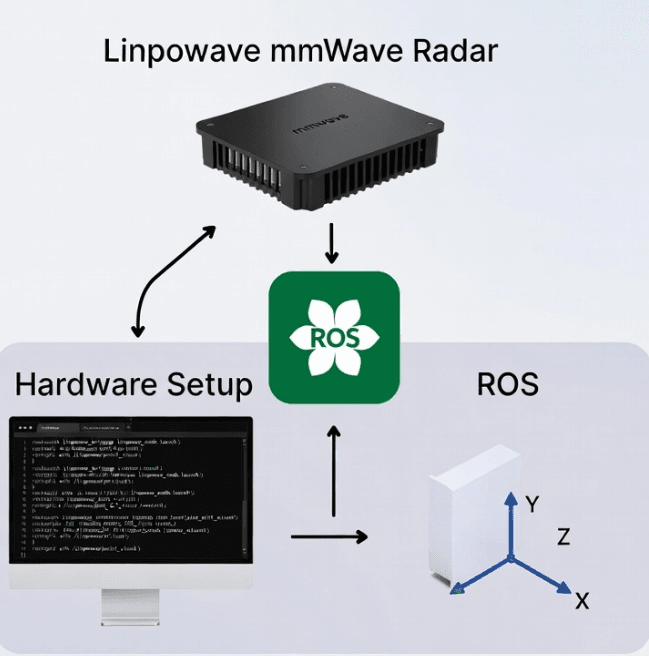As the demand for autonomous systems and intelligent sensing continues to grow, integrating Linpowave mmWave radar with the Robot Operating System (ROS) has become a key step in building advanced perception and automation systems.
This guide walks you through every step—from hardware setup and driver installation to data visualization and advanced development.
1. Hardware Preparation and Environment Setup
1.1 Hardware Requirements
-
Radar model: Linpowave mmWave radar series (compatible with ROS communication protocols)
-
Host system: Ubuntu 18.04/20.04 (ROS Melodic/Noetic) or Ubuntu 22.04 (ROS2 Humble)
-
Connection:
-
USB-to-serial adapter (e.g., FTDI XDS110) for radar-to-host connection
-
Optional 5V 3A power supply for stable standalone operation
-
1.2 Software Installation
ROS1 Installation (Ubuntu 20.04 Example)
ROS2 Installation (Ubuntu 22.04 Example)
For more details on compatible software and SDK packages, visit
👉 Linpowave SDK Documentation
2. Installing and Configuring Linpowave Radar ROS Drivers
2.1 ROS1 Driver Installation
-
Clone the Linpowave mmWave ROS driver repository
-
Set up user permissions
2.2 ROS2 Custom Message Definition
If you are using ROS2, define a custom message for detection points:
Then, generate the interface:
3. Data Collection and Processing
3.1 Launching the Radar Node
For single radar setup:
For multi-radar configuration (coordinate transform example):
3.2 Data Parsing and Storage
To store radar data in PCD format:
For advanced users, Linpowave provides a binary data interface for direct IQ and range-Doppler data parsing. See:
🔗 Linpowave Technical Documentation
4. Visualization and Advanced Development
4.1 RViz Point Cloud Display
-
Run RViz:
-
Add PointCloud2 and select
/linpowave/rscantopic -
Configure visualization parameters:
-
Color scheme: Intensity or height (Z-axis)
-
Decay time: Adjust for moving object persistence
-
TF alignment: Align radar frame with robot base frame
-
4.2 Object Clustering and Tracking
Radar point clouds can be processed for clustering and tracking:
Kalman filters can be used for motion tracking:
4.3 Open-Source Integration
-
OpenPCDet Integration: Convert Linpowave point clouds into ROS-standard format and perform 3D detection.
-
Radar-ROS Bridge: Use DDS for high-throughput communication in ROS2.
-
Multi-sensor fusion: Combine Linpowave radar with camera or LiDAR for enhanced perception.
For in-depth integration examples, refer to
🔗 ROS Wiki Documentation
🔗 OpenPCDet GitHub
5. Troubleshooting
| Issue | Possible Cause | Solution |
|---|---|---|
| No radar data stream | Serial permissions not set | Run sudo chmod 666 /dev/ttyACM* |
| No point cloud visible in RViz | Incorrect topic name | Use /linpowave/rscan |
| Radar frame misalignment | Missing TF transform | Add static transform publisher |
| Excessive noise in point cloud | Improper configuration | Adjust CFAR threshold in Linpowave config file |
6. Extended Applications
Linpowave mmWave radar can go beyond standard detection tasks and serve in multiple robotics domains:
-
SLAM Mapping: Use Linpowave radar with Cartographer or GMapping for radar-based SLAM.
-
Gesture Recognition: Analyze time-series point cloud data for human gesture control.
-
Industrial Automation: Integrate with ROS Control for radar-guided robotic arms and automated inspection systems.
Learn more about Linpowave radar applications at
🔗 Linpowave Applications
7. FAQ: Linpowave Radar + ROS Integration
Q1: Does Linpowave provide an official ROS package?
A: Yes. Linpowave offers open-source ROS1 and ROS2 packages, along with a full SDK for radar configuration and data streaming.
Q2: How can I visualize radar data in real time?
A: Use RViz or Foxglove Studio to visualize topics such as /linpowave/rscan.
Q3: Can Linpowave radar be used for SLAM or obstacle avoidance?
A: Absolutely. Linpowave radars provide dense point cloud data that enables mapping, localization, and real-time obstacle detection.
Q4: How to handle noisy or sparse radar data?
A: Tune CFAR thresholds in the Linpowave configuration file or use post-processing filters such as DBSCAN clustering.
Q5: Where can I access the official documentation and SDK?
A: Visit the Linpowave Documentation Center for drivers, SDKs, and integration tutorials.



